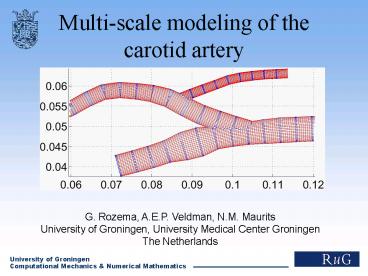Multiscale modeling of the carotid artery - PowerPoint PPT Presentation
1 / 12
Title:
Multiscale modeling of the carotid artery
Description:
Atherosclerosis in the carotid arteries is a major cause of ischemic strokes! ... wr(z,t) and wz(z,t): displacement of vessel wall in radial and longitudinal direction ... – PowerPoint PPT presentation
Number of Views:55
Avg rating:3.0/5.0
Title: Multiscale modeling of the carotid artery
1
Multi-scale modeling of the carotid artery
G. Rozema, A.E.P. Veldman, N.M.
Maurits University of Groningen, University
Medical Center Groningen The Netherlands
2
Area of interest
Atherosclerosis in the carotid arteries is a
major cause of ischemic strokes!
distal
proximal
ACI internal carotid artery
ACE external carotid artery
ACC common carotid artery
3
A multi-scale computational model Several
submodels of different length- and timescales
Carotid bifurcation
- A model for the local blood flow
- in the region of interest
- A model for the fluid dynamics ComFlo
- A model for the wall dynamics
- A model for the global cardiovascular
- circulation outside the region of interest
- (better boundary conditions)
Fluid dynamics
Wall dynamics
Global Cardiovascular Circulation
4
Computational fluid dynamics ComFlo
- Finite-volume discretization of Navier-Stokes
equations - Cartesian Cut Cells method
- Domain covered with Cartesian grid
- Elastic wall moves freely through grid
- Discretization using apertures in cut cells
- Example
- Continuity equation ? Conservation of mass
5
Boundary conditions
- Simple boundary conditions
- Future work Deriving boundary conditions from
lumped parameter models, i.e. modeling the
cardiovascular circulation as an electric network
(ODE)
Outflow
Outflow
Inflow
6
The wall dynamics (1)
wr(z,t) and wz(z,t) displacement of vessel wall
in radial and longitudinal direction
- Simple algebraic law
- Independent rings model
Elasticity
Pressure
Pressure
Elasticity
Inertia
7
Wall dynamics (2)
- Generalized string model
- Navier equations
Elasticity
Pressure
Inertia
Damping
Shear
Pressure
Shear
Inertia
Elasticity
8
Modeling the wall as a mass-spring system
- The wall is covered with pointmasses (markers)
- The markers are connected with springs
- For each marker a momentum equation is applied
- x the vector of marker positions
9
The mass-spring system compared to the
(simplified) Navier equations
- Navier equations
- Material points move in radial and longitudinal
direction only - Generalized string model
- Material points move in radial direction only
- Mass-spring system
- Material points (markers) are completely free
Conservation of momentum in all directions
Inertia
Shear
Pressure
Elasticity
Damping
10
Coupling the submodels
Carotid bifurcation
Weak coupling between fluid equations (PDE) and
wall equations (ODE) Weak coupling
between local and global hemodynamic
submodels Future work Numerical stability
Fluid dynamics PDE
pressure
wall motion
Wall dynamics ODE
Boundary conditions
Global Cardiovascular Circulation ODE
11
Results clinical data and CFD
- Example Doppler flow wave form. Model
variations Rigid wall / elastic wall,
Traction-free outflow / peripheral resistance
12
Results (2) Conclusion
- Both elasticity and peripheral resistance must be
taken into account to obtain a close resemblance
between measured and calculated flow wave forms - Future work
- Clinical follow-up data
- 3D ultrasound
- Patient specific modeling














![???? ?? Multiscale simulation for process development [Ch. 2] in Computational multiscale modeling of fluids and solids by M.O. Steinhauser PowerPoint PPT Presentation](https://s3.amazonaws.com/images.powershow.com/7058493.th0.jpg?_=201508190512)
















